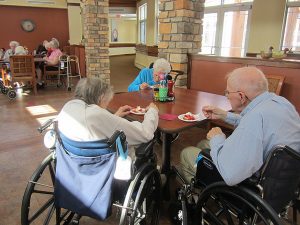
It seems to make sense intuitively that creating a smaller, more home-like atmosphere would foster improvements in nursing home residents’ psychosocial outlook.
But, there’s been little hard data to support the time and effort needed to implement culture change in institutional care. Most efforts have come from qualitative research. However, qualitative results from a 2017 study confirm that widespread adoption of a person-centered care approach makes a difference.
Researchers from LeadingAge and UMass Boston looked at how a household model of care can enhance interactions between residents and caregivers, improve dining experiences and reduce symptoms of depression.
The approach, according to this LeadingAge snapshot, provides individualized care in more home-like living environments that give residents a significant say in their daily activities, care and environment. Staff members are specifically trained to empower resident decision-making, helping to foster closer relationships with residents and families, according to this Health Services Research article.
It’s a significant change from the traditional institutional care model, but one that can make a huge difference in residents’ quality of life.
“The findings indicate that there are positive benefits of culture change. Nursing homes that implement the person-centered care model as well as doing some redesign, particularly in the dining area, can reap the benefits for the residents and for some of their staff,” said study co-author Natasha Bryant, a senior research associate at LeadingAge.
Researchers gathered data from validated, quarterly assessments of all certified nursing home residents as well as directly observed residents and caregivers. They compared outcomes at a New Jersey nursing home that used a comprehensive person-centered care approach with two similar nearby homes that only partially implemented the method. The study included three groups, totaling 68 residents, 48 trained aides, and five nurses. Each group had a similar resident to staff ratio and similar demographics.
The analysis found that comprehensive household-model residents spent less time idle or parked in wheelchairs in common areas. Also, household model residents spent more of their time talking and actively engaging with staff, especially in the dining area. Residents and trained staff also spent the most time in task-oriented interactions, including personal care. The Francis E. Parker Memorial Home, which uses the household model of care, funded the study.
The cost of cultural change is much more complex than just building new construction, Fern Marder, marketing communications manager at the Highland Park, NJ facility, said in a statement. “Culture change really is focused on three dynamics: personal, organizational and physical transformation.”
Staff must learn the value of person-directed care and be willing to try things differently, she said. Organizations also must be willing to invest in and embrace this approach, which Marder says makes for a better environment for everyone.
It costs about $4 thousand per certified nursing assistant (CNA) to train them in what’s known as the Eden Alternative method, Bryant estimated. “But it’s a different type of investment which really improves workforce culture and is a logical step for many facilities.”
As for physical transformation, many of these changes can take place without new construction. While the household model works because it feels more home-like, Marder said. sometimes just building closer relationships between staff and residents can make the building feel more like home.
“Every nursing home has the potential to be made more home-like without full renovation,” she said.
Bryant suggests that nursing homes interested in exploring this care-model approach start with the dining area because that’s where the study observed the most benefit. “Simple things like what to eat, and what time to eat, give residents more say in making decisions,” she said.
Researchers found that dining areas with more intimate spaces for conversation among residents, staff, and family, as well as having always having appetizing food available, may be more important than other aspects of the household model.
Other nursing homes and continuing care retirement communities also use the household or Green House models of care with positive results. Culture change can be challenging for an institution and staff to implement. However, evidence continues to mount that even a partial shift makes a difference in the quality of life and attitudes of nursing home residents.
Journalists wanting to report on this trend should ask whether existing nursing homes in their communities are adopting a comprehensive or partial approach to culture change by implementing the household model of care. Also ask:
- What outcomes have been observed by staff and residents?
- What approach is new construction taking? Why?
- How are homes preparing for an inevitable wave of aging baby boomers?






